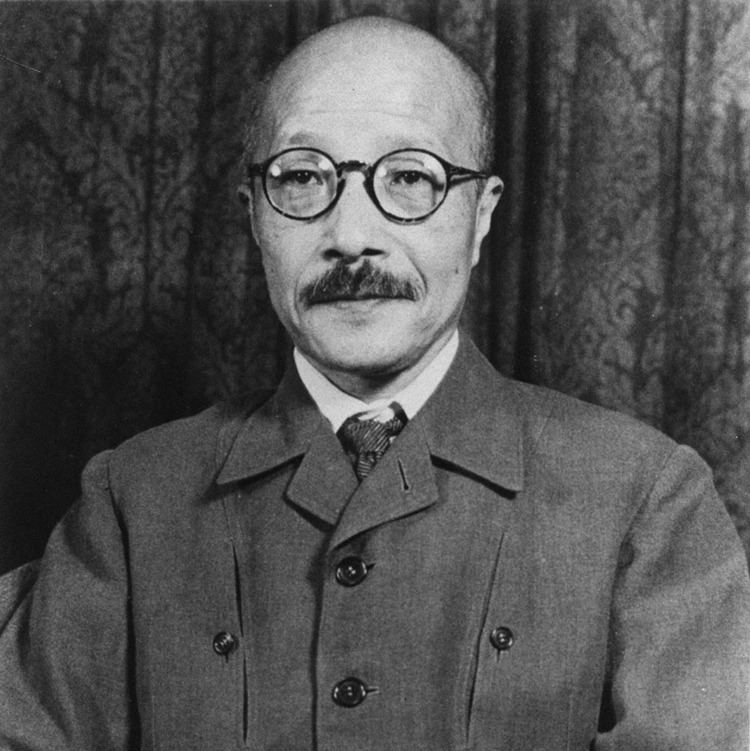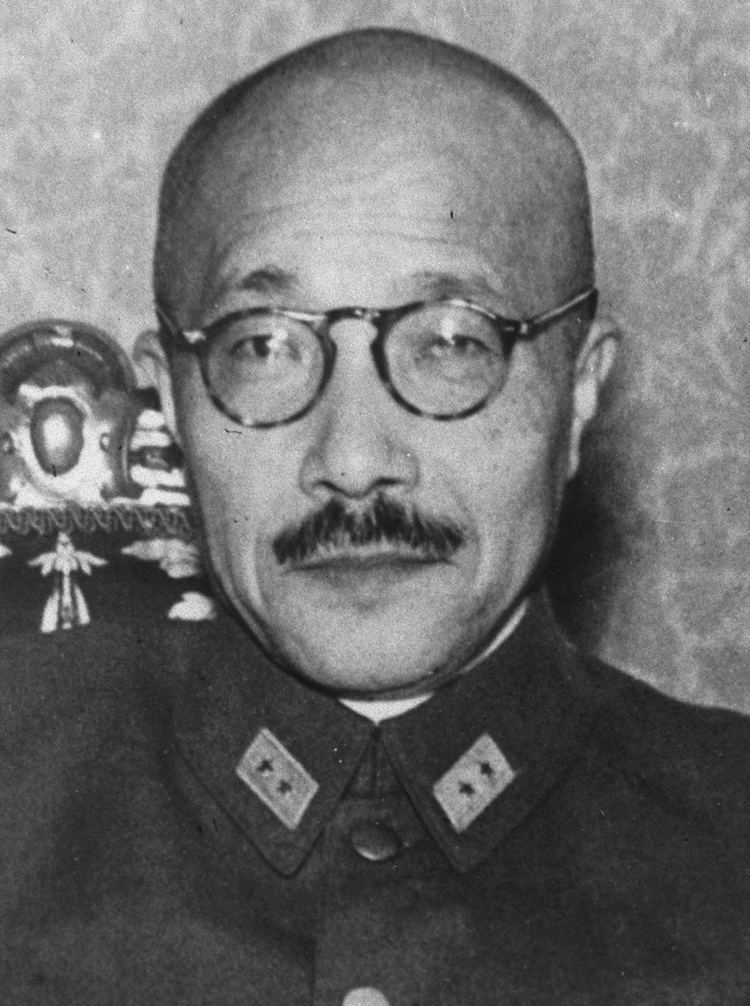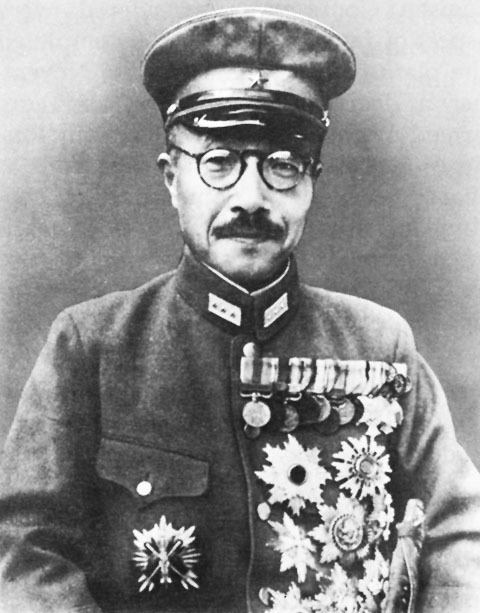Preceded by Hata Shunroku Role Military Officer | Monarch Hirohito Name Hideki Tojo | |
 | ||
Similar People Hirohito, Fumimaro Konoe, Isoroku Yamamoto, Benito Mussolini, Douglas MacArthur | ||
Hideki tojo biography
Hideki Tojo (Kyujitai: 東條 英機; Shinjitai: 東条 英機; Tojo Hideki ; December 30, 1884 – December 23, 1948) was a general of the Imperial Japanese Army (IJA), the leader of the Imperial Rule Assistance Association, and the 40th Prime Minister of Japan during much of World War II, from October 17, 1941, to July 22, 1944. As Prime Minister, he was responsible for the attack on Pearl Harbor, which initiated war between Japan and the United States, although planning for it had begun before he entered office. After the end of the war, Tojo was arrested, sentenced to death for Imperial Japanese war crimes by the International Military Tribunal for the Far East, and hanged on December 23, 1948.
Contents
- Hideki tojo biography
- Hideki Tojo
- Early life and education
- As general
- Rise to Prime Minister
- As Prime Minister
- Assassination plots
- Capture trial and execution
- Legacy
- In popular culture
- Honors
- References

Hideki Tojo
Early life and education

Hideki Tojo was born in the Kojimachi district of Tokyo on December 30, 1884, as the third son of Hidenori Tojo, a lieutenant general in the Imperial Japanese Army. In 1899, Tojo entered the Army Cadet School. When he graduated from the Japanese Military Academy (ranked 10th of 363 cadets) in March 1905 he was commissioned as a second lieutenant in the infantry of the IJA. In 1909, he married Katsuko Ito, with whom he would have three sons (Hidetake, Teruo and Toshio) and four daughters (Mitsue, Makie, Sachie and Kimie). By 1928, he had become the bureau chief of the Japanese Army, and was shortly thereafter promoted to colonel. He began to take an interest in militarist politics during his command of the 1st Infantry Regiment.
As general

In 1934, Tojo was promoted to major general and served as Chief of the Personnel Department within the Army Ministry. He was appointed commander of the IJA 24th Infantry Brigade in August 1934. In September 1935, Tojo assumed top command of the Kempeitai of the Kwantung Army in Manchuria. Politically, he was fascist, nationalist, and militarist, and was nicknamed "Razor" (カミソリ, Kamisori), for his reputation of having a sharp and legalistic mind capable of quick decision making.

During the February 26 coup attempt of 1936, Tojo and Shigeru Honjo, a noted supporter of Sadao Araki, both opposed the rebels. Emperor Hirohito himself was outraged at the attacks on his close advisers, and after a brief political crisis and stalling on the part of a sympathetic military, the rebels were forced to surrender. In the aftermath, the Toseiha faction was able to purge the Army of radical officers, and the coup leaders were tried and executed. Following the purge, Toseiha and Kodoha elements were unified in their nationalist but highly anti-political stance under the banner of the Toseiha military clique, with Tojo in the leadership position. Tojo was promoted to Chief of Staff of the Kwangtung Army in 1937. As Chief of Staff, Tojo was responsible for the military operations designed to increase Japanese penetration into the Inner Mongolia border regions with Manchukuo. In July 1937, he personally led the units of the 1st Independent Mixed Brigade in Operation Chahar, his only real combat experience.
After the Marco Polo Bridge Incident marking the start of the Second Sino-Japanese War, Tojo ordered his forces to attack Hebei Province and other targets in northern China. Tojo received Jewish refugees in accordance with Japanese national policy and rejected the resulting Nazi German protests. Tojo was recalled to Japan in May 1938 to serve as Vice-Minister of War under Army Minister Seishiro Itagaki. From December 1938 to 1940, Tojo was Inspector-General of Army Aviation.
Rise to Prime Minister
On July 22, 1940, Tojo was appointed Army Minister in the second Fumimaro Konoe regime, and remained in that post in the third Konoe cabinet. He was a strong supporter of the Tripartite Pact between Imperial Japan, Nazi Germany, and Fascist Italy. As the Army Minister, he continued to expand the war with China.
After negotiations with Vichy France, Japan was given permission to place its troops in French Indochina in July 1941. In spite of its formal recognition of the Vichy government, the United States retaliated against Japan by imposing economic sanctions in August, including a total embargo on oil and gasoline exports.
On September 6, a deadline of early October was fixed in the Imperial Conference for resolving the situation diplomatically. On October 14, the deadline had passed with no progress. Prime Minister Konoe then held his last cabinet meeting, where Tojo did most of the talking:
For the past six months, ever since April, the foreign minister has made painstaking efforts to adjust relations. Although I respect him for that, we remain deadlocked ... The heart of the matter is the imposition on us of withdrawal from Indochina and China ... If we yield to America's demands, it will destroy the fruits of the China incident. Manchukuo will be endangered and our control of Korea undermined.
The prevailing opinion within the Japanese Army at that time was that continued negotiations could be dangerous. However, Hirohito thought that he might be able to control extreme opinions in the army by using the charismatic and well-connected Tojo, who had expressed reservations regarding war with the West, although the Emperor himself was skeptical that Tojo would be able to avoid conflict. On October 13, he declared to Koichi Kido: "There seems little hope in the present situation for the Japan-U.S. negotiations. This time, if hostilities erupt, I might have to issue a declaration of war."
On October 16, Konoe, politically isolated and convinced that the Emperor no longer trusted him, resigned. Later, he justified himself to his chief cabinet secretary, Kenji Tomita:
Of course His Majesty is a pacifist, and there is no doubt he wished to avoid war. When I told him that to initiate war is a mistake, he agreed. But the next day, he would tell me: "You were worried about it yesterday, but you do not have to worry so much." Thus, gradually, he began to lean toward war. And the next time I met him, he leaned even more toward war. In short, I felt the Emperor was telling me: "My prime minister does not understand military matters, I know much more." In short, the Emperor had absorbed the views of the army and navy high commands.
At the time, Prince Naruhiko Higashikuni was said to be the only person who could control the Army and the Navy and was recommended by Konoe and Tojo as Konoe's replacement. Hirohito rejected this option, arguing that a member of the imperial family should not have to eventually carry the responsibility for a war against the West. Following the advice of Koichi Kido, he chose instead Tojo, who was known for his devotion to the imperial institution. The Emperor summoned Tojo to the Imperial Palace one day before Tojo took office.
Tojo wrote in his diary: "I thought I was summoned because the Emperor was angry at my opinion." He was given one order from the Emperor: To make a policy review of what had been sanctioned by the Imperial Conferences. Tojo, who was on the side of the war, nevertheless accepted this order, and pledged to obey. According to Colonel Akiho Ishii, a member of the Army General Staff, the Prime Minister showed a true sense of loyalty to the emperor performing this duty. For example, when Ishii received from Hirohito a communication saying the Army should drop the idea of stationing troops in China to counter military operations of Western powers, he wrote a reply for the Prime Minister for his audience with the Emperor. Tojo then replied to Ishii: "If the Emperor said it should be so, then that's it for me. One cannot recite arguments to the Emperor. You may keep your finely phrased memorandum."
On November 2, Tojo and Chiefs of Staff Hajime Sugiyama and Osami Nagano reported to Hirohito that the review had been in vain. The Emperor then gave his consent to war.
The next day, Fleet Admiral Osami Nagano explained in detail the Pearl Harbor attack to Hirohito. The eventual plan drawn up by Army and Navy Chiefs of Staff envisaged such a mauling of the Western powers that Japanese defense perimeter lines—operating on interior lines of communications and inflicting heavy Western casualties—could not be breached. In addition, the Japanese fleet which attacked Pearl Harbor was under orders from Admiral Isoroku Yamamoto to be prepared to return to Japan on a moment's notice, should negotiations succeed.
Two days later on November 5, Hirohito approved the operations plan for a war against the West and continued to hold meetings with the military and Tojo until the end of the month. On December 1, another conference finally sanctioned the "war against the United States, England, and Holland".
As Prime Minister
Tojo continued to hold the position of Army Minister during his term as Prime Minister, from October 17, 1941 to July 22, 1944. He also served concurrently as Home Minister from 1941–1942, Foreign Minister in September 1942, Education Minister in 1943, and Minister of Commerce and Industry in 1943.
As Education Minister, he continued militaristic and nationalist indoctrination in the national education system, and reaffirmed totalitarian policies in government. As Home Minister, he ordered various eugenics measures (including the sterilization of the "mentally unfit").
His popularity was sky-high in the early years of the war, as Japanese forces went from one great victory to another. However, after the Battle of Midway, with the tide of war turning against Japan, Tojo faced increasing opposition from within the government and military. To strengthen his position, in February 1944, Tojo assumed the post of Chief of the Imperial Japanese Army General Staff. However, after the fall of Saipan, he was forced to resign on July 18, 1944.
It was reported that for days after the loss of Saipan, Tojo's telephone rang and anonymous voices asked his wife, "Hasn't Tojo committed hara kiri yet?"
Assassination plots
In the summer of 1944, Major Tsunoda Tomoshige of the general staff was the leader of a plot to assassinate Prime Minister Hideki Tojo with a bomb loaded with potassium cyanide. His civilian accomplices were Ushijima Tatsukuma and Asahara Kenzo who belonged to Ishiwara Kanji's East Asia League. In July 1944, Prince Mikasa showed Prince Higashikuni a pamphlet that he had received from Tsunoda which called for the "resignation of Tojo, the establishment of a cabinet under Higashikuni, and immediate peace talks with the Allies through Moscow". The Tsunoda assassination conspiracy had been primed for July 20. They were going to deliver a bomb loaded with potassium cyanide to the prime minister's office, but when the day arrived there was no further need. The plot was uncovered in August 1944, after Tojo's resignation, when Prince Mikasa notified the Military Police about it. Tsunoda was convicted and sentenced to two years in prison, while the others were acquitted.
In October 1945, a member of the Japanese Diet disclosed that there were active groups planning to kill Tojo in January 1944, but the would-be assassins were arrested. House Member Takeo Mitamura was quoted in the Mainichi as saying the plot was formed by members of the Dan Nippon Loyalists association of Kyushu, the Imperial Assistance Youth Federation and the Truth Union.
Capture, trial, and execution
After Japan's unconditional surrender in 1945, U.S. general Douglas MacArthur issued orders for the arrest of the first forty alleged war criminals, including Tojo. Soon, Tojo's home in Setagaya was besieged with newsmen and photographers. Three American GIs (Corporal Paul Korol, Private First Class John Potkul, and Private First Class James Safford) and two Office of Strategic Services Officers (one of whom was John J. Wilpers, Jr., who received the Bronze Star for his efforts at age 90 in 2010 and died in 2013) were sent to serve the arrest warrant on Tojo.
Two American war correspondents, Hugh Bailey and Russell Braun, had previously interviewed Tojo and were also present when the attempt was made to serve the arrest warrant. Inside, a doctor named Suzuki had marked Tojo's chest with charcoal to indicate the location of his heart. When American military police surrounded the house on September 11, 1945, they heard a muffled shot from inside. Major Paul Kraus and a group of military police burst in, followed by George Jones, a reporter for The New York Times. Tojo had shot himself in the chest with a pistol, but despite shooting directly through the mark, the bullets missed his heart and penetrated his stomach.
Now disarmed and with blood gushing out of his chest, Tojo began to talk, and two Japanese reporters recorded his murmured words: "I am very sorry it is taking me so long to die. The Greater East Asia War was justified and righteous. I am very sorry for the nation and all the races of the Greater Asiatic powers. I wait for the righteous judgment of history. I wished to commit suicide but sometimes that fails."
Tojo was arrested and underwent emergency surgery in a U.S. Army hospital. After recovering from his injuries, Tojo was moved to Sugamo Prison. While there he received a new set of dentures made by an American dentist. The phrase "Remember Pearl Harbor" had been secretly drilled into the teeth in Morse code.
Thereafter, when the subsequent arrest was to occur for Admiral Shimada, military police, a physician, and an ambulance were included in that arrest process, as the U.S. learned from Tojo's suicide attempt.
Tojo was tried by the International Military Tribunal for the Far East for war crimes and found guilty of the following:
Hideki Tojo accepted full responsibility in the end for his actions during the war, and made this speech:
It is natural that I should bear entire responsibility for the war in general, and, needless to say, I am prepared to do so. Consequently, now that the war has been lost, it is presumably necessary that I be judged so that the circumstances of the time can be clarified and the future peace of the world be assured. Therefore, with respect to my trial, it is my intention to speak frankly, according to my recollection, even though when the vanquished stands before the victor, who has over him the power of life and death, he may be apt to toady and flatter. I mean to pay considerable attention to this in my actions, and say to the end that what is true is true and what is false is false. To shade one's words in flattery to the point of untruthfulness would falsify the trial and do incalculable harm to the nation, and great care must be taken to avoid this.
Tojo was sentenced to death on November 12, 1948 and executed by hanging 41 days later on December 23, 1948. Before his execution he gave his military ribbons to Private First Class Kincaid, one of his guards; they are now on display in the National Museum for Naval Aviation in Pensacola, Florida. In his final statements, he apologized for the atrocities committed by the Japanese military and urged the American military to show compassion toward the Japanese people, who had suffered devastating air attacks and the two atomic bombings.
Many historians criticize the work done by General Douglas MacArthur and his staff to exonerate Emperor Hirohito and all members of the imperial family from criminal prosecutions. According to them, MacArthur and Brigadier General Bonner Fellers worked to protect the Emperor and shift ultimate responsibility to Tojo.
According to the written report of Shuichi Mizota, interpreter for Admiral Mitsumasa Yonai, Fellers met the two men at his office on March 6, 1946 and told Yonai: "It would be most convenient if the Japanese side could prove to us that the Emperor is completely blameless. I think the forthcoming trials offer the best opportunity to do that. Tojo, in particular, should be made to bear all responsibility at this trial."
The sustained intensity of this campaign to protect the Emperor was revealed when, in testifying before the tribunal on December 31, 1947, Tojo momentarily strayed from the agreed-upon line concerning imperial innocence and referred to the Emperor's ultimate authority. The American-led prosecution immediately arranged that he be secretly coached to recant this testimony. Ryukichi Tanaka, a former general who testified at the trial and had close connections with chief prosecutor Joseph B. Keenan, was used as an intermediary to persuade Tojo to revise his testimony.
Legacy
Tojo's commemorating tomb is located in a shrine in Hazu, Aichi (now Nishio, Aichi), and he is one of those enshrined at the controversial Yasukuni Shrine. His ashes are divided between Yasukuni Shrine and Zoshigaya Cemetery in Toshima ward, Tokyo.
He was survived by a number of his descendants, including his granddaughter, Yuko Tojo, who was a right-wing nationalist and political hopeful who claimed Japan's war was one of self-defense and that it was unfair that her grandfather was judged a Class-A war criminal. Tojo's second son, Teruo Tojo, who designed fighter and passenger aircraft during and after the war, eventually served as an executive at Mitsubishi Heavy Industries.
In Japanese culture, depictions of Hideki Tojo have varied in tone and style throughout the years.
In popular culture
Honors
From the corresponding article in the Japanese Wikipedia
